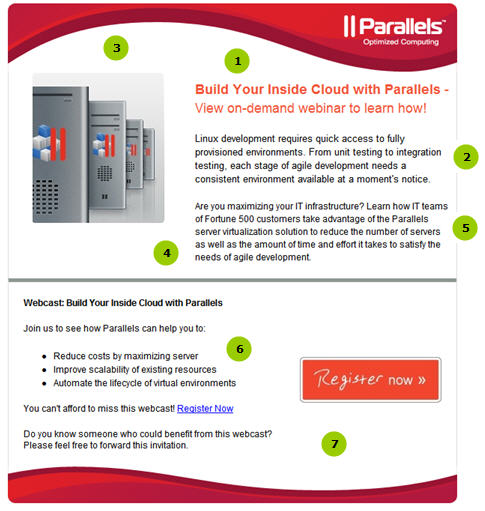I’ve written a number of times in this space about how to maximize response from email Webinar invitations. The campaign below from Parallels, a Swiss-based software company, provides a handy illustration of those techniques by displaying what key mistakes to avoid. For example:
1. Sell the offer, not the product. You don’t need to disguise your brand necessarily, but if the goal of the email is to get the reader to register for the event, the less that event appears to be a litany of reasons to buy your product, the better. “Build Your Inside Cloud” may be a hot topic to some, but add “with Parallels” and in an instant the invitation becomes a sales pitch.
 2. Lead with compelling benefits, not just facts. The first paragraph of body copy (“Linux development requires quick access …”) is a weary recitation of facts. Yes, I recognize it’s intended to “set up” reasons for attending the event, but most readers won’t get that far because they need to wade through a statement of things they already know. A better use of this space would be the bullets currently below the fold (see #6).
2. Lead with compelling benefits, not just facts. The first paragraph of body copy (“Linux development requires quick access …”) is a weary recitation of facts. Yes, I recognize it’s intended to “set up” reasons for attending the event, but most readers won’t get that far because they need to wade through a statement of things they already know. A better use of this space would be the bullets currently below the fold (see #6).
3. Use images wisely. If you must use graphic images in an email (when most email clients won’t display them anyway) at least have them relevant to the topic or the event itself (for example, a headshot of the featured speaker). Simply displaying server clipart does nothing for your message and pushes vital selling copy down the page.
4. Avoid Yes/No questions. “Are you maximizing your IT infrastructure?” is not only a cliché (what exactly does maximizing one’s infrastructure MEAN anyway?), but it also puts the onus on the reader to decide whether he/she has any reason to read further. If you must use that language, it’s better to convey the same thought as a benefit – e.g. “In just 45 minutes, learn how to maximize your IT infrastructure” – that sells the event.
5. See #1 above. Saying “Learn how IT teams … take advantage of the Parallels server virtualization solution to …” is equivalent to inviting people to discover why they should buy your product. There’s simply no reason to mention the product here. You could easily say: “Learn how Fortune 500 corporations reduce the number of servers as well as …” and still appeal to someone experiencing the very technical issues your product can solve.
6. Don’t bury your benefits below the fold. The benefit language here isn’t the strongest (ignoring the typo: maximizing server WHAT exactly?) but considering these are presumably the top three reasons to attend the event, they should be up below the headline, not buried at the end of the email.
7. Give the reader some detail. A webinar is a 45 minute commitment; it’s a tough sell. If I’m going to commit to 45 minutes or an hour out of my day, I want to know how I’ll be spending that time. At the very least, tell me who the speaker is, how long the event is, a list of topics (if not an agenda), will there be a live Q&A, etc. Here’s there’s nothing of the sort, and so registering for the event is a huge leap of faith.
For more tips on how to get the most out of your Webinar campaign, download a free copy of our white paper: “Top 10 Tips for Webinar Invitation Success.”
